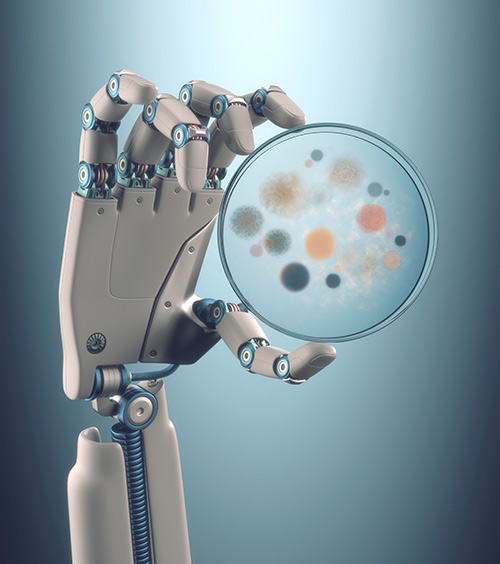![By modeling a microbiome’s gene networks, as well as an interface between a microbiome and a robotic host, scientists have shown that the host’s movements can be directed by programmed microbiome dynamics. [iStock/© ktsimage]](https://genengnews.com/wp-content/uploads/2018/08/Jul17_2015_iStock_050219834_RobtHandHoldingPetriDish1916719710-1.jpg)
By modeling a microbiome’s gene networks, as well as an interface between a microbiome and a robotic host, scientists have shown that the host’s movements can be directed by programmed microbiome dynamics. [iStock/© ktsimage]
If the Google driverless car makes you feel a bit uneasy, how will you cope with bacteria-driven robots? Such robots, declare Virginia Tech scientists, could have “brains” that rely not on neurotransmitters and electrical signals that pass between neurons, but rather on the biochemical signals that pass between microorganisms.
With bacterial communities in the driver’s seat, robotics can turn down any number of roads. They could, for example, head to the farm, the hospital, or the sea. In agriculture, bacteria-robot systems could be used to study the interactions between soil bacteria and livestock. In healthcare, further understanding of bacteria's role in controlling gut physiology could lead to bacteria-based prescriptions to treat mental and physical illnesses. In bioremediation contexts, droid-skippering bacteria could navigate toward oil spills and disperse their oil-consuming microbial brethren.
To establish that such applications are realistic, Virginia Tech’s Warren C. Ruder, Ph.D., an assistant professor of biological systems engineering, and Keith C. Heyde, a doctoral student of biomedical engineering and mechanics, created an in silico model of a living microbiome that interfaces with a biomimetic, robotic host.
“Basically we were trying to find out from the mathematical model if we could build a living microbiome on a nonliving host and control the host through the microbiome,” said Dr. Ruder. “We found that robots may indeed be able to have a working brain.”
For future experiments, Ruder is building real-world robots that will have the ability to read bacterial gene expression levels in E. coli using miniature fluorescent microscopes. The robots will respond to bacteria he will engineer in his lab.
For now, though, the most recent developments are summarized in a paper that appeared July 16 in Scientific Reports. This paper—“Exploring Host-Microbiome Interactions using an in Silico Model of Biomimetic Robots and Engineered Living Cells”—suggests that the biochemical signaling between organisms can be exploited for its sensory processing capabilities, enriching applications ranging from synthetic biology and ecology to biophysics and medicine.
The paper’s findings also add to the ever-growing body of research about bacteria in the human body that are thought to regulate health and mood, and especially the theory that bacteria also affect behavior.
“By analytically modeling and computationally simulating engineered gene networks in [modeled] commensal communities, we reproduced complex behaviors in the host,” the authors wrote. “We observed that robot movements depended upon programmed biochemical network dynamics within the microbiome.”
The study was inspired by real-world experiments where the mating behavior of fruit flies was manipulated using bacteria, as well as mice that exhibited signs of lower stress when implanted with probiotics.
Dr. Ruder's approach revealed unique decision-making behavior by a bacteria-robot system by coupling and computationally simulating widely accepted equations that describe three distinct elements: engineered gene circuits in E. coli, microfluidic bioreactors, and robot movement.
The bacteria in the mathematical experiment exhibited their genetic circuitry by either turning green or red, according to what they ate. In the mathematical model, the theoretical robot was equipped with sensors and a miniature microscope to measure the color of bacteria telling it where and how fast to go depending upon the pigment and intensity of color.
The model also revealed higher order functions in a surprising way. In one instance, as the bacteria were directing the robot toward more food, the robot paused before quickly making its final approach—a classic predatory behavior of higher order animals that stalk prey.
“By integrating an engineered microbiome, a microfluidic chemostat mimicking the microbiome’s environment within an organism, and a robotic conveyance, we have designed, modeled, and simulated a biomimetic system that allows us to explore natural phenomena through both synthetic biological and robotic programming,” the authors explained. “Much in the way that synthetic gene circuits allows the exploration of genetic pathways and relationships in a single organism, this [biomimetic system] could be used to augment and examine the interconnected networks that drive host-microbiome interactions.”


